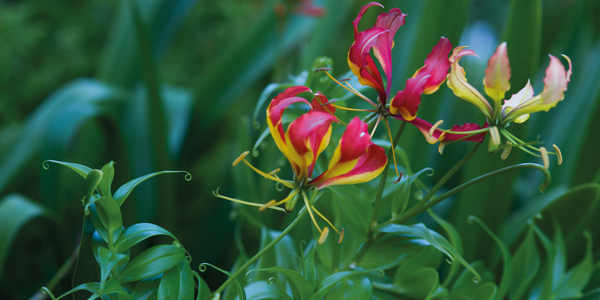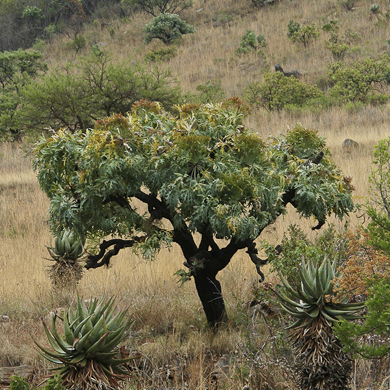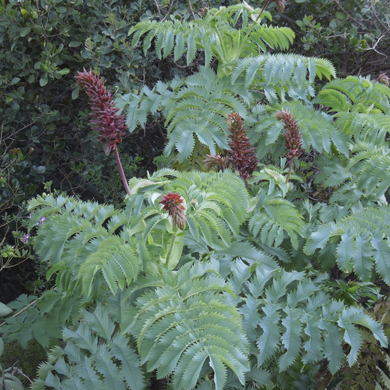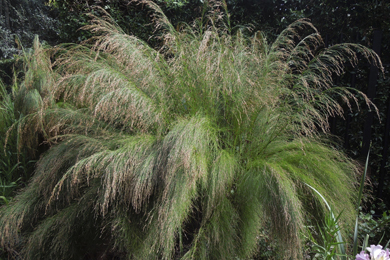Marijke Honig
An essential guide to plant selection
Quivertree –
This comprehensive, well illustrated guide is sure to become every South African gardener’s bible. Written in the first person, one gets the impression Marijke is speaking directly to you which makes using the book a personal experience.
Marijke first covers practical issues, which guide you through the basics of selecting plants, then gives advice on designing with indigenous plants – using this word rather that native – as well as basics like mulching, correct watering and feeding.

Gloriosa superba – the flame lily, illustrated in the Climbers chapter
She then goes on to describe her 24 plant ‘palettes’. These chapters cover the nitty gritty about plant selection with topics ranging from the more esoteric fragrances, birds and cut flowers to practical matters like security, screening, hedges and retaining walls, to colour, foliage and form. In each of these, using thumb print images, she introduces you to some of the most suitable plants. In some of them she has included a paragraph headed ‘My Experience’ in which she provides some insight into what she has found works for her and what hasn’t.


| Melianthus major recommended for its foliage | Cussonia paniculata the Highveld cabbage tree has an interesting form |
Rooftop and vertical gardens are becoming increasingly popular and Marijke has included some useful tips and guide lines on practical issues like soil depth and feeding as well as plant selection. In the same vein, foraging is now the in thing and she has devoted a chapter to edible plants you can grow in the garden – these include fruits and berries as well as herbs and salad greens like the “Spekboom” Portulacaria afra, and Tulbaghia violacea, the wild garlic, whose leaves can be used to add flavour to savoury dishes and its pretty purple flowers scattered over salads.
Marijke has had experience in planting up water features and the filters in natural swimming pools and her book has opened many gardeners’ eyes to what is available out there. Although many of the plants she has suggested for both water features and wetlands are often seen in these situations in the wild, they are not well known as garden plants.
South Africa is well known for its bulbs, or geophytes, and whichever climatic region you live in there will be something you can grow. She has also included, in addition to a section on plants to attract wild life, which includes birds, a chapter on nectar-producing plants which attract sunbirds. Her seasonal table will ensure that you have something for them to feed on through all four seasons.

Geissorhiza radians, a spring-flowering bulb
Of particular interest to landscapers who work with a more minimalistic plant range is her chapter on ‘grassy effects’ which includes many of the restios*, reed-like plants which take the place of grasses in the fynbos of the Western Cape, as is that on strong, bold, feature plants. As she comes from the Mediterranean region of South Africa, her comments and guide lines for growing fynbos plants are most informative.


| Restio subverticillatus, a tufted restio with finely branched foliage | Leucospermum oleifolium, a neat, rounded fynbos shrub |
The last part of the book is an extensive plant directory, covering all of the 440 plants she has mentioned, with magnificent photographs and succinct yet full descriptions of each plant.
The key to the symbols used to depict plants’ frost tolerance, preference for sun or shade and water requirements etc, is easily accessed on the inside back cover.
Review by Marianne Alexander – Cape Horticultural Society
Images courtesy of the publisher
Editor’s note:
* Restio is short for the plant family Restionaceae of over 500 species of perennial evergreen, grass-like plants. They look like a hybrid of grass, bamboo, rush and horsetail – but are related to none of them. They vary in size from 10cm plants to 3m. Many are hardy to minus 8C.
Suppliers of restios and other South African plants in France:
And in the UK:
Other suppliers of South African plants in France are:
Pépinière Railhet, based in Saint-Jory, north of Toulouse
Pépinière Issa, based in Valflaunès, north of Montpellier
Or directly from South Africa:
